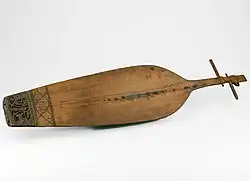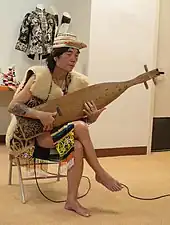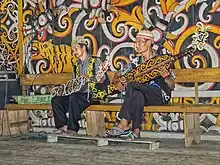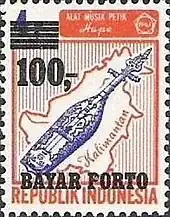Sapeh
Sapeh, also spelt as Sape, Sapeʼ, Sapek, Sapeik, Sapeq, Sampeh, Sampeʼ, Sampek, or Sampeq (/sʌpɛʔ/) is the traditional Dayak string instrument of Borneo-origin that commonly developed in northern, eastern,[2] and western of Kalimantan. It is a wooden-base instrument with some simple strings attached, works similar way like the guitar(s).
 The Tropenmuseum collection of Sapeh from East Kalimantan, c. 1900s | |
| String | |
|---|---|
| Other names | Sape, Sapeʼ, Sapek, Sapeik, Sapeq, Sampeh, Sampeʼ, Sampek, or Sampeq |
| Classification | String instrument |
| Hornbostel–Sachs classification | (Composite chordophones) |
| Developed | Apo Kayan, North Kalimantan, Indonesia[1] |
| Related instruments | |
| lute | |


Since 1950s, these string instruments from all regions all across Indonesian Archipelago has been officially recognized by the Indonesian government as one of the national Intangible Cultural Heritages of Indonesia in the domains of Traditional Skills and Crafts, Community Customs, Rites, and Celebrations, Performing Arts, as well as Traditions and Expressions of the Natives, and has been digitilized since at least 2010.[3][4][5][6][7] Its originality and development are also regulated and protected by both the national laws of the Republic of Indonesia and international laws.[8] Some notable native Dayak maestros of these musical instrument are also highly valued and respected by Indonesia and has been awarded in some Anugerah Kebudayaan (lit. 'Cultural Award(s)'), such as mr. Arang from Bulungan[9] and mr. Irang Awai from Kutai.[10][11]
History
The Sape (in Kenyah dialect means ‘scratching’) is a traditional plucked lute chordophone family of instruments used by many of the Orang Ulu (Kayan, Kenyah, Kelabit), who live in the longhouses that line the rivers of Kayan. Sape originated from the Apau Kayan highlands in Indonesia.
_in_Tenggarong_TMnr_10005749.jpg.webp)

It was first in prime performed in public during the Tenggarong's native festival of Erau in 13th century. Since then, the popularity Sapeh later spread to another regions of Kalimantan, even deep into the inland of the island in western of Tenggarong. During its development, the Sapeh also transformed as electrical-based string instrument and first patented in East Kalimantan.[12] Nowadays, it is played amongst the Dayak multiethnic community which could traced its ancestral origin in southern, central, and eastern regions of Kalimantan. In recent times, the northern and western regions of the island such as North Kalimantan,[9] West Kalimantan, the Malaya-occupied state of Sarawak are also gradually influenced by its neighbouring territory, the Sapeh was mainly introduced there by the natives of Kayan River.
Cultural significance
_in_de_Apo_Kajan_op_Oost-Borneo%252C_KITLV_174159.tiff.jpg.webp)

The performance of Sapeh was first publicly debut in the 13th century era during the Tenggarong's native festival of Erau. Its cultural values has always been connected to Java, thus the Sapeh sometimes used in religious activities of Kaharingan as well, which is a form of folk religion heavily influenced by Javanese Hinduism. Perceived as the means of ancestral and deities respect, the Sapeh also played with accompaniment of chants of folk songs.
In East Kalimantan particularly, the natives of Samarinda, West Kutai, and Mahakam Ulu have their own distinctive instrumental tones of Sapeh namely the Tubunsitun which characterized by its melodious gentle tone and Sakpakok which characterized by its fast and dynamic tone.[13]
References
- Gennaro, Thomas (2015-05-23). "The Sape". Asian Itinerary. Retrieved 2023-04-20.
- Gennaro, Thomas (2015-05-23). "The Sape". Asian Itinerary. Retrieved 2023-07-30.
- "Sape'" [Sape']. Intangible Cultural Heritages of Indonesia (in Indonesian). Ministry of Education and Culture of the Republic of Indonesia. 2010. Archived from the original on 2022-05-21. Retrieved 2021-03-06.
- "Sape Kalimantan Barat" [Sape of West Kalimantan]. Intangible Cultural Heritages of Indonesia (in Indonesian). Ministry of Education and Culture of the Republic of Indonesia. 2017. Archived from the original on 2023-03-25. Retrieved 2023-04-01.
- "Ta'a, Sapei, dan Sapaq" [Ta'a, Sapei, and Sapaq]. Intangible Cultural Heritages of Indonesia (in Indonesian). Ministry of Education and Culture of the Republic of Indonesia. 2017. Archived from the original on 2023-03-25. Retrieved 2023-04-01.
- "Sapeq" [Sapeq]. Intangible Cultural Heritages of Indonesia (in Indonesian). Ministry of Education and Culture of the Republic of Indonesia. 2018. Archived from the original on 2023-03-25. Retrieved 2023-04-01.
- "Sapeik" [Sapeik]. Intangible Cultural Heritages of Indonesia (in Indonesian). Ministry of Education and Culture of the Republic of Indonesia. 2018. Archived from the original on 2023-03-25. Retrieved 2023-04-01.
- "Law and Regulation of the Republic of Indonesia" (in English and Indonesian). World Intellectual Property Organization (WIPO). Archived from the original on 2023-03-25. Retrieved 2023-04-01.
- "Arang, Maestro Alat Musik Sampe'" [Arang, the Maestro of Sampe’ Musical Instrument] (in Indonesian). Directorate of Cultural Heritage and Diplomacy, Directorate General of Culture of the Republic of Indonesia. 2015. Archived from the original on 2023-03-25. Retrieved 2023-04-01.
- "Irang Awai: "Musik Menjaga Keseimbangan Alam"" [Irang Awai: "Music Maintains Nature's Balance"] (in Indonesian). Directorate of Cultural Heritage and Diplomacy, Directorate General of Culture of the Republic of Indonesia. 2017. Archived from the original on 2023-03-25. Retrieved 2023-04-01.
- "Profil Penerima Anugerah Kebudayaan Indonesia 2017 Kategori Maestro Seni Tradisi : Irang Awai" [Profile of the 2017 Indonesian Culture Award Recipient for Traditional Arts Maestro Category: Irang Awai] (in Indonesian). Directorate of Cultural Heritage and Diplomacy, Directorate General of Culture of the Republic of Indonesia. 2017. Archived from the original on 2023-03-25. Retrieved 2023-04-01.
- "Undang-Undang Republik Indonesia Nomor 13 Tahun 2016 Tentang Paten" [Law of the Republic of Indonesia No. 13 of 2016, on Patents] (in English and Indonesian). World Intellectual Property Organization (WIPO). 2016. Archived from the original on 2023-03-25. Retrieved 2023-04-01.
- "Sape, Alat Musik Kalimantan Mampu Berkolaborasi Dengan Musik Moderen" [Sape: The Traditional Musical Instrument of Kalimantan Now Collaborated With Modern Musics] (in Indonesian). Dinas Komunikasi dan Informatika Provinsi Kalimantan Timur [Official Communication and Information Agency of East Kalimantan]. 2021. Archived from the original on 2023-03-25. Retrieved 2023-04-01.